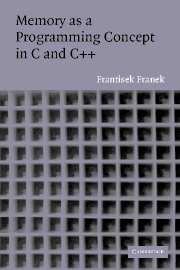Book contents
- Frontmatter
- Contents
- Acknowledgments
- Dedication
- 1 Introduction
- 2 From Source File to Executable File
- 3 Variables and Objects; Pointers and Addresses
- 4 Dynamic Allocation and Deallocation of Memory
- 5 Functions and Function Calls
- 6 One-Dimensional Arrays and Strings
- 7 Multi-Dimensional Arrays
- 8 Classes and Objects
- 9 Linked Data Structures
- 10 Memory Leaks and Their Debugging
- 11 Programs in Execution: Processes and Threads
- A Hanoi Towers Puzzle
- B Tracing Objects in C++
- C Tracing Objects and Memory in C++
- D Thread-Safe and Process - Safe Reporting and Logging Functions
- Glossary
- Index
6 - One-Dimensional Arrays and Strings
Published online by Cambridge University Press: 13 January 2010
- Frontmatter
- Contents
- Acknowledgments
- Dedication
- 1 Introduction
- 2 From Source File to Executable File
- 3 Variables and Objects; Pointers and Addresses
- 4 Dynamic Allocation and Deallocation of Memory
- 5 Functions and Function Calls
- 6 One-Dimensional Arrays and Strings
- 7 Multi-Dimensional Arrays
- 8 Classes and Objects
- 9 Linked Data Structures
- 10 Memory Leaks and Their Debugging
- 11 Programs in Execution: Processes and Threads
- A Hanoi Towers Puzzle
- B Tracing Objects in C++
- C Tracing Objects and Memory in C++
- D Thread-Safe and Process - Safe Reporting and Logging Functions
- Glossary
- Index
Summary
Static one-dimensional arrays and their representation as pointers. Array indexing as indirection. Why an array index range check cannot be performed in C/C++. The price of run-time array index range checking; “compile-time checking” versus “run-time checking” philosophies. Passing static one-dimensional arrays as function arguments. Definition versus declaration of one-dimensional arrays. Dynamic one-dimensional arrays. Strings as static or dynamic one-dimensional char arrays terminated with NULL. How to add a custom-made run-time index range checker in C++.
The most frequently used composite data structures in programming are arrays. Since their use is so ubiquitous, they are provided as almost built-in data types in C/C++. Unfortunately, the emphasis is on “almost” and not on “built-in”. On the one hand, “almost” here means that you need not provide any programmatic means of creating (building) and indexing the array and that any C/C++ compiler will provide both automatically. The array definition/declaration and access to the array items through indexing are thus integral parts of the C/C++ language. On the other hand, “almost” also means there is no innate data type array in C/C++ that is treated in its own special way, so each array is represented by an appropriate pointer pointing to an appropriate storage according to appropriate conventions. This has some unexpected consequences for “index out of range” run-time errors and for passing array arguments to functions.
The fundamental notion of an array is just an extension of the basic model of computer memory: an array of bytes accessible through indexes (their addresses).
Information
- Type
- Chapter
- Information
- Memory as a Programming Concept in C and C++ , pp. 81 - 96Publisher: Cambridge University PressPrint publication year: 2003
